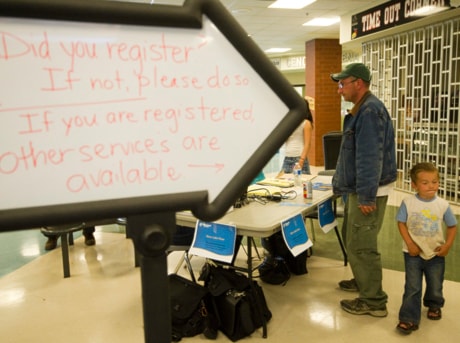ATHABASCA — Frustration mounted Tuesday for thousands of evacuees trying to find out if they have homes to return to after a wildfire reduced a large part of their town to cinders.
“You don’t know what you have back there anymore,” said Patty Lewis, who was staying at an evacuation centre in Athabasca, southeast of the burned-out community of Slave Lake.
“You don’t even know when you can go home. We were told we could go home in a couple of days. Now we’ve been told two weeks, so I don’t know.”
Resident Laurie Northeast added: “People want to know who lost their home and who didn’t. Do we have something to go back to? Is there a reason to go back?”
Lewis, Northeast and about 7,000 other Slave Lake residents were ordered out of town Sunday night when forest fires — whipped up by 100 km/h winds — swooped in and set fire to homes, businesses and cars. The flames turned entire neighbourhoods into wastelands of burnt concrete, black grass and twisted metal.
Officials and police are not letting residents back into the town, 250 kilometres northwest of Edmonton, because the smoke is too heavy, chemicals hang in the air and there is no electricity, power or drinking water.
Mayor Karina Pillay-Kinnee said while it may be a couple of weeks before residents can return, officials are trying to at least get word to people about which properties have been damaged or destroyed.
“It is a priority. I understand the frustration of residents,” said Pillay-Kinnee.
“In the next day or two we hope to have a system set up where they can access their private information.”
Wildfire spokesman Rob Harris said the town on the shore of Lesser Slave Lake isn’t considered safe. The freight-train winds that whipped sparks and embers onto rooftops Sunday have abated to about half their strength, but the blaze is not under control.
“It really depends on the weather,” said Harris, who works for Sustainable Resource Development.
“If we get strong winds like we saw on the weekend, it’s still a possibility (that the fire could re-enter the community),” he said.
“Until we classify it as being held, we still expect it to grow.”
Residents who fled are staying with friends or family or at one of three evacuation centres as far south as Edmonton.
Colin Lloyd of Alberta Emergency Services said 95 per cent of the town’s population has moved out, but some citizens have refused to leave.
“A very small number of people have been found in the town,” he said. “They are being dealt with by police.”
RCMP spokesman Tim Taniguchi said there have been three reports of property-crime related offences.
“Looting is not happening,” he said. “We have a strong police presence.”
A tour of the community Monday revealed devastation that destroyed over one-third of the town. Some areas were levelled, while others were hit in patchwork fashion.
Many homes were torched to their foundations. There were automobiles scorched to a yellow-grey with tires melted down to the rims. Green lawns were burnt to black ashes beside concrete front steps that led nowhere.
The blaze destroyed the town hall, library and radio station but spared the police station, school and hospital.
Harris said 80 firefighters from Ontario and another 200 from British Columbia were arriving to assist the 1,000 smoke eaters battling the blazes around Slave Lake and across the province.
They were being assisted by heavy equipment on the ground, along with 124 helicopters and 20 air tankers.
“We virtually have every single heavy helicopter in Canada working on fires in Alberta. Those are the big ones, the biggest you can get,” said Harris.
It’s estimated there are 100 wildfires in Alberta, about a quarter of which are out of control.
Harris says it has been a tough fire season and it’s only just beginning. About 1,000 square kilometres were burning Tuesday — more than the entire fire season in 2010, he said.
“That just goes to illustrate how significant those winds were, how large a role they played in fire growth.”
— With files from Dean Bennett in Edmonton
